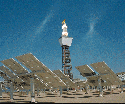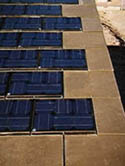



Photovoltaics (PV) - Introduction
Throughout the history of mankind the sun has inspired worship, awe and fear. In ancient Egypt, it was the sun god Ra who held the supreme place among all deities as the giver of life. In Greek and Roman legend, the sun was a fiery chariot driven across the face of the sky.
We can only imagine how those ancient people might respond to the sight of thin, shiny rectangles harnessing the sun’s awesome energy. Even today with knowledge of scientific principles, observers are astonished by the technology of photovoltaics.
Photovoltaic cells convert sunlight directly into electricity. They have successfully powered space satellites since 1958 and now furnish electricity for a wide variety of applications on earth.
Solar-generated electricity powers water pumps, weather monitoring stations, fire watchtowers, and billboard lights, irrigation system, streetlights, boat battery chargers, and numerous other devices in Arizona and throughout the world. Glistening photovoltaic panels can easily be seen at Tucson bus stops, atop many roadside emergency telephones, and near artwork along Phoenix freeways.
Solar cells in space work in a vacuum at extremely high or extremely low temperatures while exposed to intense radiation. Other systems have been used on frozen tundra, in scorching deserts and on mountain peaks. Tougher tests for a young technology would be hard to design.
Nevertheless, photovoltaic systems have established a record of reliability and have proven cost effective for many uses. They produce no pollution in creating electricity and require no water to operate. As environmental problems escalate and solar cells costs are reduced, these systems will almost certainly play an important role in our energy future.
The remainder of the "Photovoltaics" pages are here:

